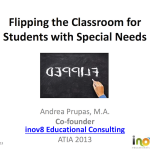 We recently presented our ideas and current work on “Flipping the classroom for students with special needs” at ATIA 2013. As we have posted previously, the flipped classroom has been making some big waves in the last year in both K-12 and in higher education. We’ve been working on this initative and wanted to share our resources so that we can generate ideas and discussion in this new and growing area.
We recently presented our ideas and current work on “Flipping the classroom for students with special needs” at ATIA 2013. As we have posted previously, the flipped classroom has been making some big waves in the last year in both K-12 and in higher education. We’ve been working on this initative and wanted to share our resources so that we can generate ideas and discussion in this new and growing area.
In our session, we challenged the notion that the benefit for flipping the classroom for students with special needs lies solely in the “ability to watch the content over and over again” within the online tutorials that teachers can use to create materials. While we feel that online tutorials are beneficial for individual needs for many reasons (ex. a highly visual approach can be used to present content) we feel that other benefits stem from the fact that the classroom can become a more interactive, collaborative and authentic place for learning. Using David Thornburg‘s concept, we approached flipping the classroom for students with special needs with his idea of “doing things differently vs. doing different things.”
Flipping the classroom for students with special needs – Presentation at ATIA:
Flipped classroom for students with special needs – List of tools:
We also presented tools that can be used for flipping the classroom from three perspectives:
- Those that can be used outside of the classroom only (content curation and interactive screencasting)
- Those that can be used both inside or outside the classroom (screensharing, interactive polling) and
- Those used mainly for use inside the classroom (digital storytelling, blogging/microblogging, concept mapping).
We created a handout that you might want to use as a quick reference:
[scribd id=123293380 key=key-2bicylqmg5l4orx7lwxi mode=scroll]
Flipping the classroom for students with special needs – Case study:
Lastly, we prepared a case study on flipping the classroom for students with special needs using a specialized approach for students with learning disabilities in the area of math problem solving and financial literacy. We merged a research-based approach with tools for flipping the classroom to create an example of what a lesson plan could look like. Our case study is embedded below:
[scribd id=123567250 key=key-1qftn0jd3d6r2xg13fke mode=scroll]
We enjoyed discussing flipping the classroom for students with special needs and the great feedback we received from our colleagues at the conference (ATIA is always a great experience!) Please post your thoughts below, we would love to get the conversation going!

Hi,
I hope you will excuse me for this comment on your blog rather than an email but I have created a new bookmarking site for parents of children with special needs. You can submitany links you like that are newsworthy to fellow parents. The site also automatically bookmark news stories and new posts from relevant bloggers.
If you want your site to the auto bookmarking, just email me. I need your RSS feed. For wordpress sites it is [your domain name name]/feed.
I have set up a special twitter account that will tweet all the bookmarks and news automatically. Please follow @forspecialneeds if you are interested.
Best wishes
Duncan
(Dad to a child with Dravet Syndrome)
iwant to know more abou it